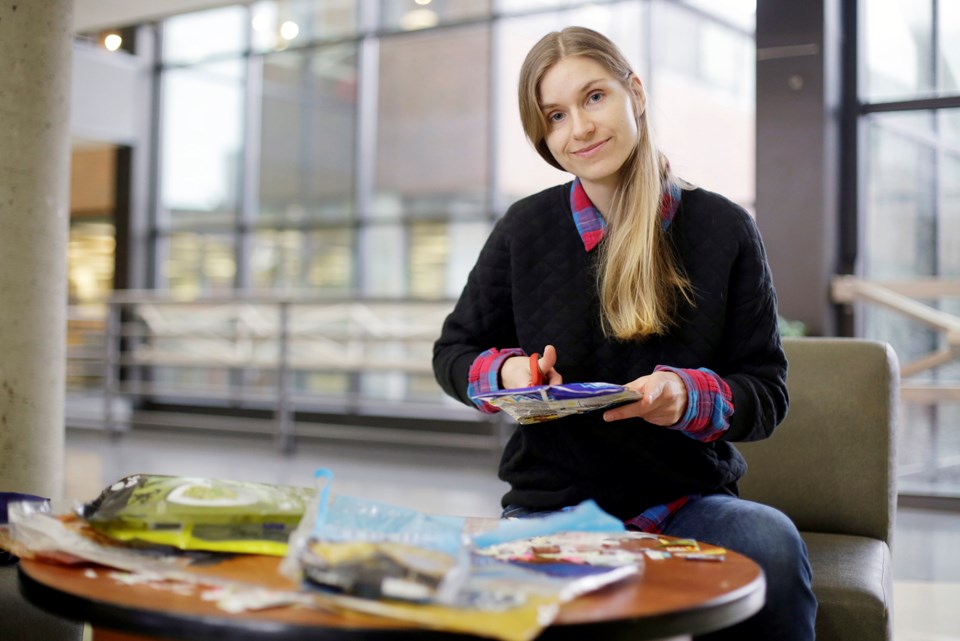Molly Marineau was that kid out in the yard, getting her hands dirty while she built little cities out of grass and earth. She was also the kid rearranging cans in the grocery store aisles to make them look more organized.
She figures it’s those two sides of her personality that led her to where she is today: embarking upon a stint as the city’s first Solid Waste and Recycling Artist in Residence.
Yes, you read that right.
The city’s engineering and arts services departments are teaming up for the program, which will give Marineau a five-month term – from Feb. 1 to June 30 – as the artist in residence. She’ll work out of both the Anvil Centre and office space in the city’s engineering operations yard (a.k.a. the works yard, home of recycling operations, garbage trucks, signage and a whole lot more), using whatever she finds from the city’s recycling operations to turn it into art.
“It’s a really cool and unique opportunity for me,” Marineau says. “It sounds like I can just sort of make myself at home. I’m just going to go with the flow and see what works.”
The residency is a natural extension of the work Marineau has already been doing.
The Idaho native channelled her lifelong interests in being creative and in “organizing the world” into studies in architecture. It was during an elective course in art history at the University of Idaho that Marineau discovered the conceptual art movement, which focused on the ideas behind art rather than its traditional formal and visual elements. It was also where she discovered the idea of making art out of found objects and set herself on a new artistic path.
After moving to Vancouver a few years ago when her partner came to UBC to study architecture, she found herself drawn to create work based on the things she found in her travels. She collects things from the sidewalk as she travels the city – especially grocery lists and handwritten notes – and takes them back to her studio to turn them into art.
“I feel like I’m connecting with the city, in a way,” she says.
This residency will allow her to expand on that foundation. She already has many ideas in mind – she has a sketchbook full of pages of concepts to explore – but she’s open to being inspired by anything and everything she finds.
“I like to work pretty experimentally,” she says, noting she’ll be working with video, sculpture, painting, embroidery, mixed media and more to create her work. “I’m glad I have five months to explore.”
As she works, Marineau says, there’s a natural inclination to question issues surrounding our culture: issues of environment, waste, consumerism and more.
“It’s hard when you live in a culture to see outside of it, to see it from the outside in,” she says. “Artwork about waste, about recycling, about garbage, about the environmental effects of garbage, is a really good way to bring up those subjects.”
Marineau notes there’s a tendency in our culture to try to just forget about waste: we throw stuff away and the city deals with it; only a small number of people ever have to actually think about what we do with the waste.
“I think it’s really cool that New Westminster is hiring artists to talk about waste,” she says. “Artists are good at seeing through cultural veils.”
Moreover, she says, exploring those issues through art allows people to reframe the conversation about waste and the environment. Those are subjects we tend to think of in a negative way, she says – “we shouldn’t be consuming so much, we shouldn’t be littering,” and so on and so on – but art allows her to frame the issues and questions in a more positive way.
Along the way, she’ll also be open to input from the public. Although the exact form and shape of her outreach has yet to be decided, Marineau notes there will be opportunities along the way for people to get involved in her work.
Once Marineau’s residency finishes, the plan is for a series of artists to continue the role. That’s something Marineau finds exciting, noting that each artist will have their own vision for how the residency will unfold.
For Marineau, the opportunity to take on this residency is a step towards making art her career rather than simply a sideline (at the moment, she also has a job in the kitchen at The Arbor restaurant in Vancouver).
“It’s been a hobby up till now,” she says. “I want to amp it up to be a career path.”
For New West residents, Marineau will be maintaining a blog as she works, chronicling her adventures in art at the engineering operations yard. You can follow along at www.mollydoesart.com/NewWest.



